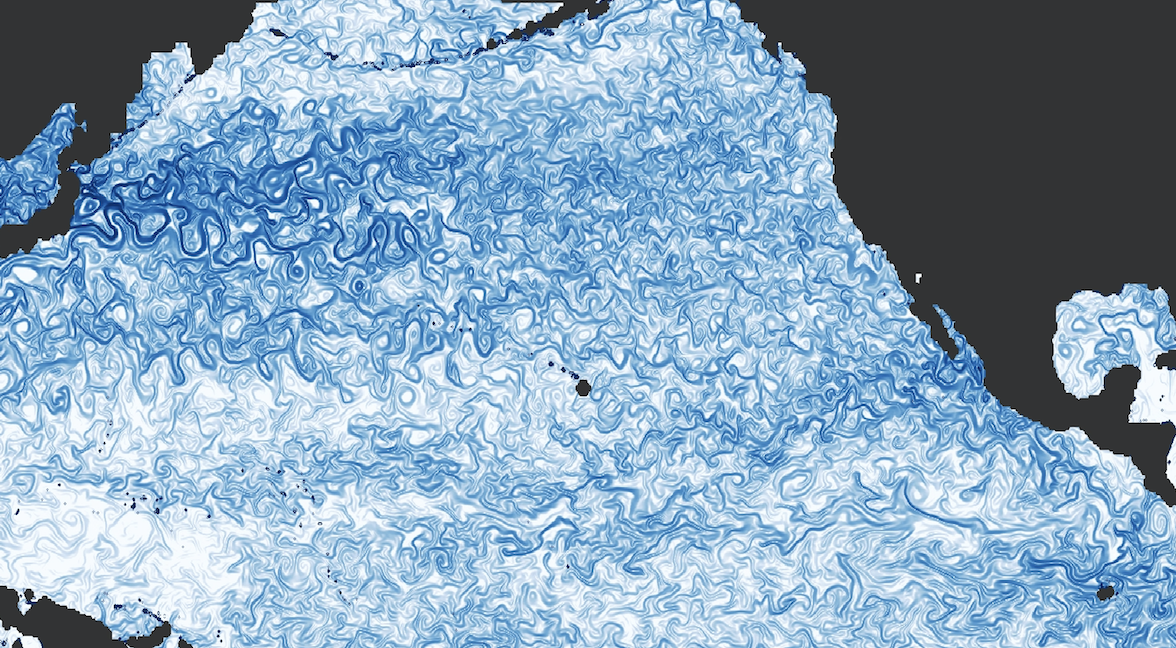story by Helen Hill for MITGCM

This month we spotlight work by researchers Julius Busecke and Ryan Abernathey who have been using MITgcm in a study geared towards developing a time-resolved global dataset of surface lateral mesoscale eddy diffusivities.
Mesoscale turbulence (on scales of between 50 and 200 km) is a ubiquitous feature of ocean dynamics and with a significant impact on the meridional overturning circulation, and water mass formation, as well as the transport of tracers, recurring climate features like the El Niño–Southern Oscillation (ENSO) variance and ecosystem dynamics.

Julius Busecke is currently a postdoc working in Laure Resplandy’s group at Princeton. He has been using MITgcm since ~2015. He says, “I especially appreciated the extensive documentation since this was my first time working with a numerical model.” When not hard at work on oceanography, Julius enjoys taking pictures, rock climbing and exploring “his home/favorite place in the world” New York.
Diffusion coefficients quantify the rate at which mixing processes transport tracers and are used in coarse-resolution climate models to represent unresolved transport processes. The flanks of western boundary currents exhibit diffusivities up to 10,000 m2s−1, while values on the order of 100 m2s−1 are found in the subtropical gyres. Previous work on mesoscale mixing has focused on estimating the long-term mean diffusivity and its spatial variability.
The use of such spatially variable diffusivities, rather than constant values, in global climate models or inverse methods strongly affects the estimated ocean uptake of carbon and rates of water mass formation motivating the authors to investigate whether and how mesoscale diffusivities change over time, as a possible missing element in future climate projections.
In their new paper “Ocean mesoscale mixing linked to climate variability”, published in Science Advances, Julius Busecke (Princeton, formerly Columbia) and Ryan Abernathey (Columbia) present the first time-resolved global dataset of lateral mesoscale eddy diffusivities at the ocean surface, which the pair obtained by applying so-called suppressed mixing length theory to satellite-observed velocities.

Ryan Abernathey is currently an Assistant Professor at Columbia University. According to our records he has been an MITgcm user since 2006
“Persistent periods of increased/decreased mesoscale mixing could have a major impact on the transport of ocean tracers, particularly when these periods are connected to other fluctuating components of the climate system,” says Busecke. “This applies to both interannual to decadal climate variability and forced trends due to anthropogenic release of carbon dioxide. However, there have been very few studies of the interannual variability in the mesoscale mixing process.”
Busecke and Abernathey report finding interannual variability throughout the global ocean, regionally correlated with climate indices such as ENSO, NAO, DMI, and PDO, with changes in mixing length, driven by variations in the large-scale flow, often exceeding the effect of variations in local eddy kinetic energy, previously thought of as the primary driver of variability in eddy mixing.
They posit that this mechanism, not currently represented in global climate models, could have far-reaching consequences for the distribution of heat, salt, and carbon in the global ocean, as well as ecosystem dynamics and regional dynamics such as ENSO variance.
The authors used the MITgcm in offline mode to simulate passive tracer advection, an integral step to independently verify surface diffusivities diagnosed from satellite altimetry.
Eddy mixing at the ocean surface from Julius Busecke on Vimeo. Illustration of the process of eddy mixing. Properties are stirred, gradients increased leading to stronger diffusion. Advection of a passive tracer (based on sea surface temperature) with observed velocities from satellites. Visualization of results from Busecke and Abernathey (2019)
To find out more about this work contact Julius
Follow Julius on twitter
This Month’s Featured Publication
- Julius J. M. Busecke and Ryan P. Abernathey (2019), Ocean mesoscale mixing linked to climate variability, Science Advances, doi: 10.1126/sciadv.aav5014
Related
Julius Busecke, Ryan P. Abernathey, and Arnold L. Gordon (2017), Lateral Eddy Mixing in the Subtropical Salinity Maxima of the Global Ocean, Journal of Physical Oceanography, doi: 10.1175/JPO-D-16-0215.1 – Here Julius et al used similar MITgcm model experiments but a different methodology with a focus on the effect of eddy mixing for the surface salinity of the subtropical gyres in the world ocean.
Other New Publications this Month
Abu Asaduzzaman, Demian Riccardi, Akef T. Afaneh, Sarah J. Cooper, Jeremy C. Smith, Feiyue Wang, Jerry M. Parks, and Georg Schreckenbach (2019), Environmental Mercury Chemistry – In Silico, Accounts of Chemical Research, doi: 10.1021/acs.accounts.8b00454
Le Chang, He Tang, Shuang Yi and Wenke Sun (2019), The Trend and Seasonal Change of Sediment in the East China Sea Detected by GRACE, Geophysical Research Letters, doi: 10.1029/2018GL081652
A. A. Cimatoribus, U. Lemmin, D. A. Barry (2019), Tracking Lagrangian transport in Lake Geneva: A 3D numerical modeling investigation, Limnology and Oceanography, doi: 10.1002/lno.11111
Bertrand L. Delorme and Leif N. Thomas (2019), Abyssal Mixing through Critical Reflection of Equatorially Trapped Waves off Smooth Topography, Journal of Physical Oceanography, doi: 10.1175/JPO-D-18-0197.1
Fabio Di Sante, Erika Coppola, Riccardo Farneti, Filippo Giorgi (2019), Indian Summer Monsoon as simulated by the regional earth system model RegCM-ES: the role of local air-sea interaction, Climate Dynamics, doi: 10.1007/s00382-019-04612-8
Mariangel Garcia, Paul F. Choboter, Ryan K. Walter, Jose E. Castillo (2019), Validation of the nonhydrostatic General Curvilinear Coastal Ocean Model (GCCOM) for stratified flows, Journal of Computational Science, doi: 10.1016/j.jocs.2018.11.012
Ch. Helling, P. Gourbin, P. Woitke, and V. Parmentier (2019), Sparkling nights and very hot days on WASP-18b: the formation of clouds and the emergence of an ionosphere, arXiv:1901.08640 [astro-ph.EP]
Manfredi Manizza, Dimitris Menemenlis, Charles, E. Mille, Hong Zhang (2019), Modeling the recent changes in the Arctic Ocean CO2 sink (2006–2013), Global Biogeochemical Cycles, doi: 10.1029/2018GB006070
Jolanta Nastula, Małgorzat Wińska, Justyna Śliwińska, David Salstein (2019), Hydrological signals in polar motion excitation – Evidence after fifteen years of the GRACE mission, Journal of Geodynamics, doi: 10.1016/j.jog.2019.01.014
Qihua Peng, Shang-Ping Xie, Dongxiao Wang, Xiao-Tong Zheng and Hong Zhang (2019), Coupled ocean-atmosphere dynamics of the 2017 extreme coastal El Niño, Nature Communications, doi: 10.1038/s41467-018-08258-8
Antoine Renaud, Louis-Philippe Nadeau, and Antoine Venaille (2019), Periodicity disruption of a model quasi-biennial oscillation, arXiv:1901.05076 [physics.flu-dyn]
Sinha, Anirban (2019), Temporal Variability in Ocean Mesoscale and Submesoscale Turbulence, Columbia University Doctoral Thesis, doi: 10.7916/d8-bngk-r215
Steinrueck, Maria E, Vivien Parmentier, Adam P. Showman, Joshua Lothringer, Roxana Lupu (2019), The effect of disequilibrium carbon chemistry on the atmospheric circulation and phase curves of hot Jupiters, American Astronomical Society, http://adsabs.harvard.edu/abs/2019AAS…23312304S
D. S. Trossman, and R. H. Tyler (2019), Predictability of Ocean Heat Content From Electrical Conductance, Journal of Geophysical Research – Oceans, doi: 10.1029/2018JC014740
Ufuk Utku Turuncoglu (2019), Toward modular in situ visualization in Earth system models: the regional modeling system RegESM 1.1, Geoscientific Model Development, doi: 10.5194/gmd-12-233-2019
Jinbo Wang, Lee-Lueng Fu, Hector S. Torres, Shuiming Chen, Bo Qiu, Dimitris Menemenlis (2019), On the Spatial Scales to be Resolved by the Surface Water and Ocean Topography Ka-Band Radar Interferometer, Journal of Atmospheric and Oceanic Technology, doi: 10.1175/JTECH-D-18-0119.1
Jamie D. Wilson, Stephen Barker, Neil R. Edwards, Philip B. Holden, and Andy Ridgwell (2019), Sensitivity of atmospheric CO2 to regional variability in particulate organic matter remineralization depths, Biogeosciences, doi: 10.5194/bg-2018-509
Yang Yang, X. San Liang (2019), The intrinsic nonlinear multiscale interactions among the mean flow, low-frequency variability and mesoscale eddies in the Kuroshio region, Science China Earth Sciences, doi: 10.1007/s11430-018-9289-4
Do you have news about research using MITgcm? We are looking for contributions to these pages. If you have an interesting MITgcm project (ocean, atmosphere, sea-ice, physics, biology or otherwise) that you want to tell people about, get in touch. To make a post, contact Helen

